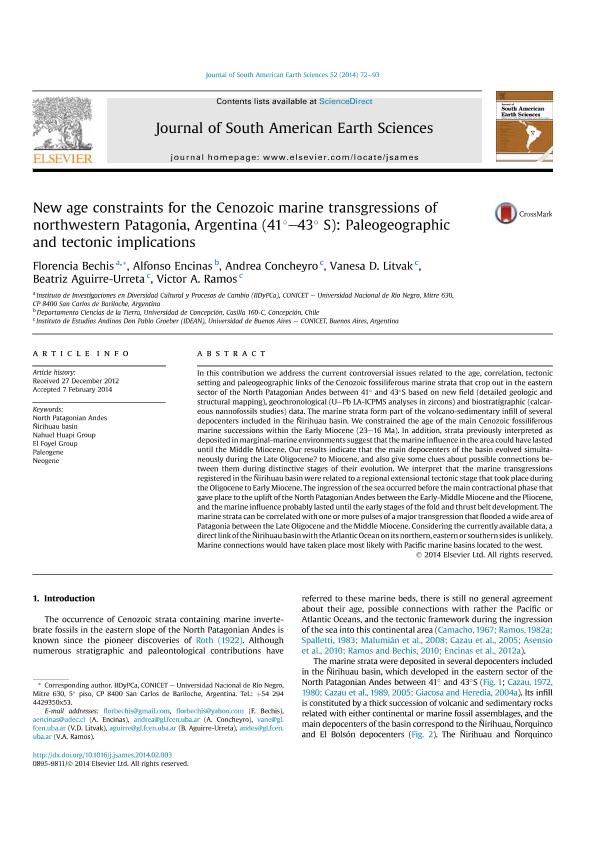Artículo
New age constraints for the Cenozoic marine transgressions of northwestern Patagonia, Argentina (41°-43° S): Paleogeographic andtectonic implications
Bechis, Florencia ; Encinas, Alfonso; Concheyro, Graciela
; Encinas, Alfonso; Concheyro, Graciela ; Litvak, Vanesa Dafne
; Litvak, Vanesa Dafne ; Aguirre-Urreta, Maria Beatriz
; Aguirre-Urreta, Maria Beatriz ; Ramos, Victor Alberto
; Ramos, Victor Alberto
 ; Encinas, Alfonso; Concheyro, Graciela
; Encinas, Alfonso; Concheyro, Graciela ; Litvak, Vanesa Dafne
; Litvak, Vanesa Dafne ; Aguirre-Urreta, Maria Beatriz
; Aguirre-Urreta, Maria Beatriz ; Ramos, Victor Alberto
; Ramos, Victor Alberto
Fecha de publicación:
01/2014
Editorial:
Pergamon-Elsevier Science Ltd
Revista:
Journal of South American Earth Sciences
ISSN:
0895-9811
Idioma:
Inglés
Tipo de recurso:
Artículo publicado
Clasificación temática:
Resumen
In this contribution we address the current controversial issues related to the age, correlation, tectonic setting and paleogeographic links of the Cenozoic fossiliferous marine strata that crop out in the eastern sector of the North Patagonian Andes between 41° and 43°S based on new field (detailed geologic and structural mapping), geochronological (U-Pb LA-ICPMS analyses in zircons) and biostratigraphic (calcareous nannofossils studies) data. The marine strata form part of the volcano-sedimentary infill of several depocenters included in the Ñirihuau basin. We constrained the age of the main Cenozoic fossiliferous marine successions within the Early Miocene (23-16Ma). In addition, strata previously interpreted as deposited in marginal-marine environments suggest that the marine influence in the area could have lasted until the Middle Miocene. Our results indicate that the main depocenters of the basin evolved simultaneously during the Late Oligocene? to Miocene, and also give some clues about possible connections between them during distinctive stages of their evolution. We interpret that the marine transgressions registered in the Ñirihuau basin were related to a regional extensional tectonic stage that took place during the Oligocene to Early Miocene. The ingression of the sea occurred before the main contractional phase that gave place to the uplift of the North Patagonian Andes between the Early-Middle Miocene and the Pliocene, and the marine influence probably lasted until the early stages of the fold and thrust belt development. The marine strata can be correlated with one or more pulses of a major transgression that flooded a wide area of Patagonia between the Late Oligocene and the Middle Miocene. Considering the currently available data, a direct link of the Ñirihuau basin with the Atlantic Ocean on its northern, eastern or southern sides is unlikely. Marine connections would have taken place most likely with Pacific marine basins located to the west.
Palabras clave:
El Foyel Group
,
Nahuel Huapi Group
,
Neogene
,
North Patagonian Andes
,
Paleogene
Archivos asociados
Licencia
Identificadores
Colecciones
Articulos(IDEAN)
Articulos de INSTITUTO DE ESTUDIOS ANDINOS "DON PABLO GROEBER"
Articulos de INSTITUTO DE ESTUDIOS ANDINOS "DON PABLO GROEBER"
Articulos(IIDYPCA)
Articulos de INST. DE INVESTIGACIONES EN DIVERSIDAD CULTURAL Y PROCESOS DE CAMBIO
Articulos de INST. DE INVESTIGACIONES EN DIVERSIDAD CULTURAL Y PROCESOS DE CAMBIO
Citación
Bechis, Florencia; Encinas, Alfonso; Concheyro, Graciela; Litvak, Vanesa Dafne; Aguirre-Urreta, Maria Beatriz; et al.; New age constraints for the Cenozoic marine transgressions of northwestern Patagonia, Argentina (41°-43° S): Paleogeographic andtectonic implications; Pergamon-Elsevier Science Ltd; Journal of South American Earth Sciences; 52; 1-2014; 72-93
Compartir
Altmétricas



